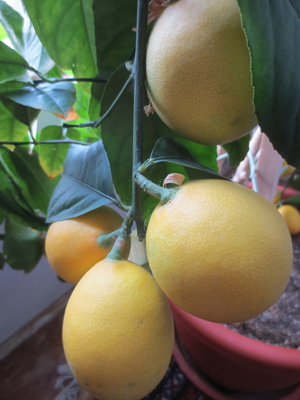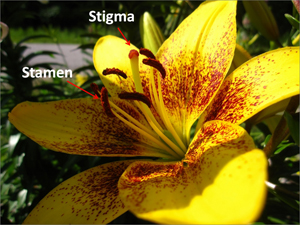Winter Lemons
Winter is a bleak time for most of Canada. I’m not going to glamorize it. For those of us who can’t go six months without tending to some greenery, there are indoor plants. I like to grow a variety of flowering plants that bloom at different times to give me something interesting to look at throughout the winter months.
Right now, along with an amaryllis, my Meyer lemon tree is fruiting! That’s right, it has flowered and now has fruit. Edible fruit I should add. My favourite part of the tree is its ease in growing. A few key rules and you’re on your way to delicious orangey-lemon citrus fruit in no time.

The Soil
In Canada, your Meyer lemon will need to come indoors for the winter. It is best to keep it in a manageable pot that you can transport easily. Choose a sandy loam soil: potting soil will do just fine.
Watering
Keep a young tree well watered to get it established. You want the soil to be moist, not sopping. Established or mature trees will benefit from soil that dries out between waterings. Water well when you do water and make sure there is sufficient drainage so your plant isn’t sitting in water.
Feeding
A healthy Meyer lemon needs to be fed every once in a while. Using a fertilizer made specifically for fruiting trees, apply every 6-8 weeks or according to the directions on the fertilizer (each will be different so it’s best to follow the given instructions).
Light
Your indoor tree will need as much light as it can get in the winter: I’m talking six hours of sunlight. In the winter, direct sunlight won’t hurt the tree. In the summer, however, when the sun is stronger and the days longer, you will want to make sure the leaves aren’t being burned.
If you take your plant outdoors for the summer, morning sun is best and partial sun in the afternoon will ensure the tree receives plenty of sunlight without its leaves being compromised.
Temperature
Keep temperatures fairly regular: 18 degrees is ideal during the day, 15 at night.
Insects and Disease
When you bring your plant home, it is best to quarantine it from other plants. If there are insects present, you will likely notice them within the first 3-4 weeks. Treat as necessary: remember that some are more difficult to treat than others (I’m looking at you mealy bug).
Fruit
Like other fruiting trees, pollination is necessary for fruit to occur. But unlike many other fruiting trees, the Meyer lemon is self-pollinating which means you only need one tree to produce fruit. All you have to do is get the pollen from one flower to another. In nature, the plant would be wind or insect pollinated. Indoors, however, it could need help.
Using a Q-tip, collect pollen from the stamen and rub it onto a stigma. The photo below is a lily but it shows clearly the difference between the stamen (pollen covered bit) and stigma (inner blob-like structure).

Alternatively, you can take your chances by giving the tree a gentle shake to loosen the pollen and cause it to fall from the stamen to the stigma.
(I have successfully harvested 3 crops from my Meyer lemon without ‘assisting’ the pollination. The plant flowers every year and produces fruit without my help.)
The fruit itself is delicious: it’s been described by others as a combination of an orange and a lemon and I would have to agree. And after all that typing, I think it’s about time I enjoy one!



